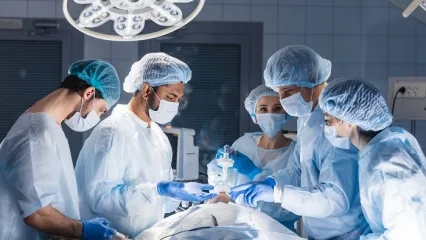Alo Yeditepe
Alo Yeditepe
Early Detection Is Cancer's Most Powerful Enemy
Colon cancer, one of the five most common types of cancer in our country, is usually seen in people over the age of 50. However, if there are some familial diseases such as ulcerative colitis or familial polyposis, they can be seen under the age of 50 or even in our 20s. Prof. Dr. Özcan Gökçe, the head of the General Surgery Department of Yeditepe University pointed out that eating excessive fatty foods and consuming fried foods generally played an important role in the emergence of the disease, and also noted that obesity and smoking also come to the fore as risk factors.
In some people over the age of 50, small protrusions called polyps begin to form on the mucous surface that lays inside the large intestine. About 20-30 percent of these structures, called adenomatous polyps, develop colon cancer. As the number increases, so does the risk. Noting that polyp characteristics determine risk factors, Yeditepe University Medical Faculty Head of General Surgery Department and Yeditepe University Kozyatağı Hospital General Surgery Specialist Prof. Dr. Gökçe gives the following information: "If the base of these polyps is wide, the probability of cancer is high, while in fungal formations, that is, if the stem is thinner, the probability decreases. Sessile polyps with large soles need to be removed without delay. Some polyps called villous adenomas are also more susceptible to colon cancer. The rate of conversion of these polyps to colon cancer, especially in the last part of the large intestine, is stated to be 100 percent. Therefore, in people with villous adenoma, polyps should be removed at an early stage and treated before they develop into colon cancer. Just because a person has polyps does not always mean that they will get cancer. For example, inflammatory polyps do not cause cancer, while adenomatous polyps are defined as pre-cancerous. Therefore, if a pathological examination of a polyp reveals that it is adenomatous, it should be carefully monitored."
Symptoms Manifest with Bleeding
The polyps on the left side of the large intestine are manifested by bleeding, and the ones on the right side are manifested by a decrease in hemoglobin value in the blood. Villous adenomas, on the other hand, give symptoms with the slimy secretion that comes with feces. In almost all large intestinal tumors, especially those on the left side, the presence of linear bleeding foci on the stool in any way may be a sign of colon cancer. Stating that the symptoms of the tumors on the right and left sides are also different, Prof. Dr. Gökçe said, "The part of the large intestine up to the middle is defined as the right colon, and the part after the middle is defined as the left colon. Tumors on the left side are often symptomatic with blockages such as stool and constipation because the diameter of the intestine is smaller in the left colon. On the right side, the large intestine diameter is wider, so it does not clog but leads to a decrease in hemoglobin in the blood. In general, tumors on the left are diagnosed early and those on the right are diagnosed late."
Early Diagnosis Matters
People over the age of 50 need to have a colonoscopy regularly, as well as the way they eat to protect themselves from colon cancer. Those with a family history of cancer should have a regular colonoscopy every year, and those without a family history should have a regular colonoscopy every five years. Individuals with a family history are at least seven times more likely to develop the disease than the rest of the population. It is also important that everyone over the age of 50 undergoes regular stool occult blood tests, except for colonoscopy. If the result of this test is positive, the patient should be evaluated by colonoscopy. However, any bleeding, including hemorrhoids, can be effective in causing a positive test result.
Therapy Can Also Be Given During Colonoscopy
The treatment of colon cancer can be achieved by removing the polyps detected in the early period by colonoscopy. However, for this, there must be one, fungal type of polyp, and there must be no tumors in the stalk. In cases where regular colonoscopy is not performed, these types of colon cancer are manifested in more advanced stages. Under these conditions, the entire large intestine may need to be removed by performing basic surgery. Underlining that in the presence of familial polyps called multiple polyposes, it may be necessary to remove all of them since polyps can settle in the entire large intestine, Prof. Dr. Gökçe said, "Such surgeries should be performed on a wide range of lymph nodes as much as possible. This will ensure that there is no visible tumor in the body."
Liver Tumor Needs to Be Removed
Colon cancers can also spread to the liver. However, this does not mean that the patient cannot be treated. Unlike other types of cancer, if there is a spread to the liver, it is recommended that the liver tumor, that is, its metastasis, be removed as much as possible with the surgical removal of the large intestine tumor in the same session. Especially in tumors called the rectum, which are close to the exit of the colon, the proximity to the anus region gains importance.
Chemotherapy and Radiotherapy Can Also Be Added to the Treatment
The vast majority of surgically treated colon cancer patients can be given chemotherapy, sometimes radiotherapy. A multidisciplinary treatment approach for colon cancer comes to the forefront at this point. Patients are followed up and treated by a team including an oncologist. Emphasizing that the treatment is usually started with surgery, followed by chemotherapy, but if the tumor is located below the anus, the stage of the tumor is reduced with chemotherapy and radiotherapy beforehand, Prof. Dr. Gökçe said, "The tumor can be removed surgically after it reaches the surgical limits. This is called the sandwich treatment. In some cases, chemotherapy is applied first, followed by surgery. Finally, if necessary, chemotherapy can be combined with radiotherapy."
Press Coverage: hurriyet.com | cnnturk.com | milliyet.com | oncevatan.com | haberler.com
About
Faculty and Year of Graduation:
Hacettepe University Faculty of Medicine, 1980
”
See Also
- What is a Liver Transplant, How is it Done? and Who is it For?
- What is Gallbladder Surgery?
- Patched Solution for Umbilical Hernia
- What are the Symptoms and Treatment Methods of Cirrhosis?
- 3 Major Developments Shaping Treatment in Colon Cancer
- Can Weight Loss Despite Not Dieting Be a Sign of Cancer?
- The Biggest Obstacle to Early Diagnosis of Breast Cancer: LACK OF INFORMATION
- He Came to Turkey to Get Rid of the Colostomy Bag
- Breast Protective Surgery Is Not Recommended in the Treatment of Multifocal Breast Cancer
- Breast Cancer Has Dethroned Lung Cancer for The First Time! But, Why?
- Liver Cancer (Tumor) and Treatment
- Gallbladder Stones
- What Is Appendicitis?
- Hemorrhoid Treatment
- Questions About Gastroenterology Surgery
- Surgery for Breast Cancer and Breast Aesthetics Can Be Performed Simultaneously
- New Study Surprised: “Mortality Increased in Breast Cancer Cases Under the Age of 40”
Alo Yeditepe





